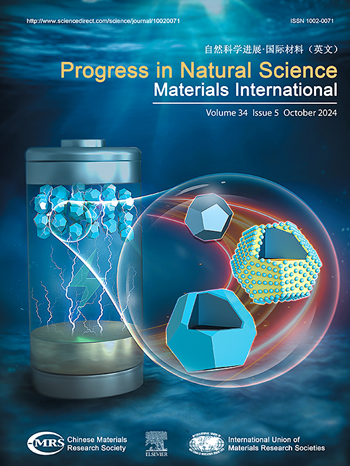黏土矿物修复重金属的结构工程:分子机制、性能增强和可持续应用
IF 7.1
2区 材料科学
Q2 MATERIALS SCIENCE, MULTIDISCIPLINARY
Progress in Natural Science: Materials International
Pub Date : 2025-06-01
DOI:10.1016/j.pnsc.2025.03.008
引用次数: 0
摘要
全球城市化和工业扩张的加速导致有毒重金属(Cr、As、Cd、Hg、Cu、Pb)的排放对水生系统造成严重污染,对生态完整性和公众健康构成重大威胁。在多种修复策略中,吸附因其操作效率和成本效益而成为一种特别有前途的解决方案,而吸附剂的开发是主要的技术障碍。天然存在的粘土矿物(高岭石、蒙脱土和坡面石等)已成为水净化应用的优越候选者,利用其固有的地质丰度、结构多样性、可修饰的表面化学和卓越的吸附能力。本文系统地综述了近年来粘土基材料在重金属吸附方面的科学进展,重点分析了其晶体学性质、分子水平吸附机理(静电相互作用、离子交换、表面络合、氢键)和关键操作参数(pH、温度、离子强度)。一项专门的评估表明,通过化学改性(表面活性剂插入、官能团接枝)和纳米级工程,粘土复合材料的性能得到了显著提高,与原始材料相比,性能得到了显著提高。通过建立结构-功能关系和优化改性方案,该分析为开发下一代粘土吸附剂提供了重要指导,为通过地质来源的修复技术解决人为污染挑战绘制了一条可持续的途径。本文章由计算机程序翻译,如有差异,请以英文原文为准。

Structural engineering of clay minerals for heavy metal remediation: Molecular mechanisms, performance enhancement, and sustainable applications
The acceleration of global urbanization and industrial expansion has precipitated severe contamination of aquatic systems through toxic heavy metal discharges (Cr, As, Cd, Hg, Cu, Pb), creating substantial threats to ecological integrity and public health. Amidst diverse remediation strategies, adsorption emerges as a particularly promising solution due to its operational efficiency and cost-effectiveness, with adsorbent development constituting the primary technological hurdle. Naturally occurring clay minerals (kaolinite, montmorillonite, and palygorskite, etc.) have emerged as superior candidates for water purification applications, leveraging their inherent advantages of geological abundance, structural diversity, modifiable surface chemistry, and exceptional adsorption capabilities. This review systematically synthesizes recent years of scientific advancements in heavy metal sequestration using clay-based materials, with focused analysis on crystallographic properties, molecular-level adsorption mechanisms (electrostatic interaction, ion exchange, surface complexation, hydrogen bond), and critical operational parameters (pH, temperature, ionic strength). A dedicated evaluation of clay composites demonstrates remarkable performance enhancements through chemical modification (surfactant intercalation, functional group grafting) and nanoscale engineering, achieving significant capacity improvements compared to pristine counterparts. By establishing structure-function relationships and optimizing modification protocols, this analysis provides crucial guidance for developing next-generation clay adsorbents, charting a sustainable pathway for addressing anthropogenic pollution challenges through geologically-sourced remediation technologies.
求助全文
通过发布文献求助,成功后即可免费获取论文全文。
去求助
来源期刊
CiteScore
8.60
自引率
2.10%
发文量
2812
审稿时长
49 days
期刊介绍:
Progress in Natural Science: Materials International provides scientists and engineers throughout the world with a central vehicle for the exchange and dissemination of basic theoretical studies and applied research of advanced materials. The emphasis is placed on original research, both analytical and experimental, which is of permanent interest to engineers and scientists, covering all aspects of new materials and technologies, such as, energy and environmental materials; advanced structural materials; advanced transportation materials, functional and electronic materials; nano-scale and amorphous materials; health and biological materials; materials modeling and simulation; materials characterization; and so on. The latest research achievements and innovative papers in basic theoretical studies and applied research of material science will be carefully selected and promptly reported. Thus, the aim of this Journal is to serve the global materials science and technology community with the latest research findings.
As a service to readers, an international bibliography of recent publications in advanced materials is published bimonthly.

 求助内容:
求助内容: 应助结果提醒方式:
应助结果提醒方式:


